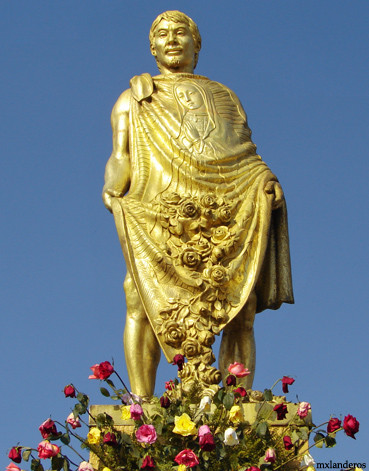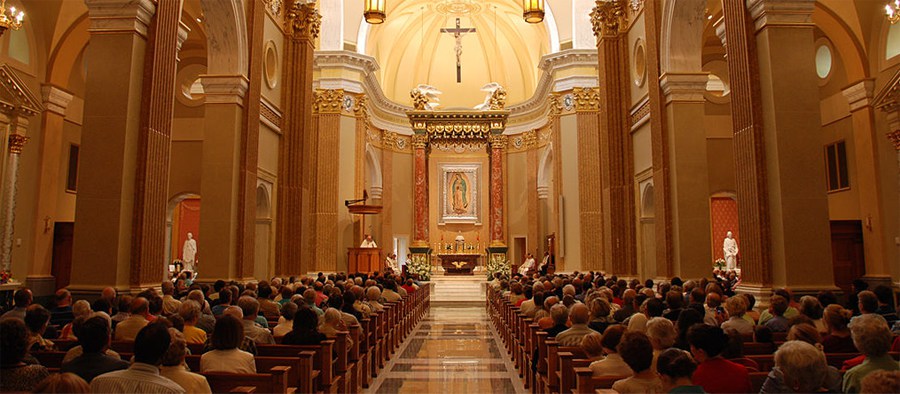Our Lady of Guadalupe and the Miracle of Divine Love
This mysterious picture of Jesus and Mary is a kind of theological text on divine love and human dignity.
One of the great Christian communicators in American history, Archbishop Fulton J. Sheen, described Mary, the mother of Jesus, as she is seen in the Catholic and Orthodox traditions: a human being free of personal sin, simply and wholly pleasing to God, not through her own efforts but through the saving grace of Christ working retroactively. On this view Mary is simply the perfect Christian, the one plain human being whose earthly image is exactly what God had in mind for her. She is in that sense a window into the very mind of God.
Our evangelical friends take a different view, of course. They see the apostle Paul’s statement that “all have sinned and fallen short of the glory of God” as applying to Mary. At the same time, they also recognize her as an extraordinarily Godly woman, chosen by God to bear and raise the son of God, and in her faithful response to the angel Gabriel demonstrating one of the great moments of faith in all of Scripture.
Whichever view you take, you can’t ignore Mary’s role in the spread of faith in her Son across the world. Over centuries, Catholics have believed that Jesus has sent His mother from time to time to appear to certain people, to offer encouragement, or a warning, or to call us to more fervent prayer. Typically, these “apparitions” have been to the poor, the weak, the forgotten in society, and yet the words believed have changed the fate of nations.
That is what happened in Mexico, in early December 1531, when an Indian peasant named Juan Diego, one of the few who had followed the Spanish missionaries who had accompanied the conquistadors into that country, was climbing the hill of Tepeyac. At the top, so the story goes,
he saw a brilliant light on the summit and heard the strains of celestial music. Filled with wonder, he stopped. Then he heard a feminine voice asking him to ascend. When he reached the top he saw the Blessed Virgin Mary standing in the midst of a glorious light, in heavenly splendor. The beauty of her youthful countenance and her look of loving kindness filled Juan Diego with unspeakable happiness as he listened to the words which she spoke to him in his native language. She told him she was the perfect and eternal Virgin Mary, Mother of the true God, and made known to him her desire that a shrine be built there where she could demonstrate her love, her compassion and her protection. “For I am your merciful Mother,” she said, “to you and to all mankind who love me and trust in me and invoke my help. Therefore, go to the dwelling of the Bishop in Mexico City and say that the Virgin Mary sent you to make known to him her great desire.”
Mary did not speak Spanish, or wear the courtly clothes of the conquerors. Instead she appeared as a woman whom Juan Diego might have seen in any village. But she spoke of the love of God for the Mexican people, in a way that no foreign friar could hope to do. So Juan Diego dutifully marched off to the bishop, Fray Juan de Zumarraga, who heard Juan Diego’s case, but did not believe him. Juan Diego returned to Tepeyac Hill to pray, and he said that Mary sent him back to bother the bishop.
 At the second meeting, the bishop suggested that Juan Diego ask for some sign of proof. A few days later, the Virgin appeared to Juan Diego and told him to gather roses and bring them to the bishop. Juan Diego was astonished to see, in the midst of winter, an explosion of unfamiliar flowers all around him. He gathered them in his humble tunic (called a “tilma”) and carried them to the bishop’s palace.
At the second meeting, the bishop suggested that Juan Diego ask for some sign of proof. A few days later, the Virgin appeared to Juan Diego and told him to gather roses and bring them to the bishop. Juan Diego was astonished to see, in the midst of winter, an explosion of unfamiliar flowers all around him. He gathered them in his humble tunic (called a “tilma”) and carried them to the bishop’s palace.
Bishop Zumarraga was stunned by the flowers, of a breed which grew only in his native region of Spain. He was even more taken aback by what had happened to Juan Diego’s tilma: It bore a magnificent, mysterious image of the Virgin Mary, pregnant with Jesus. He was convinced. So were the native people of Mexico, who hearkened to the story and flocked to the shrine that Bishop Zumarraga built in Guadalupe, which enshrined the mysterious tilma — an ordinary garment, made of cheap materials that typically decay in just a few years, which never aged or lost its luster over the next 500 years. Millions still flock to see it today.
The Image of the Image of God
That’s a lovely story. But is it anything more than that? Even some Catholic scholars argue that the the very Catholic figures in the region in the decades following the apparition whom one would most expect to have written about the event are silent about it. Others point to a document from only a few years afterwards that mentions the event, now regarded by the Catholic Church as authentic. Christians of good will can disagree about the story, of course. For our part, we are convinced that the story is true history, and we take great encouragement from that conviction. But even if one takes it as only a beautiful painting and story, there is a wealth of theological insight in them. The image of Mary and Jesus that appeared on that tilma is a kind of book — a theology text that teaches us critical lessons that modern man has forgotten.
First of all, the image teaches us about human dignity, and where it comes from. If Mary is a perfect reflection of God’s vision of her in his own mind, then in this portrait we have a picture of how God sees mankind: more important than all of nature, since Mary stands on top of the moon, is backlit by the sun, and is clothed in the stars of heaven (reflecting the description in Revelation 12:1). The human person, which our Culture of Death treats as a means to pleasure and power, is in fact much more important than the rest of the created universe.
What gives us such dignity and importance? Only the grace of God. Mary’s head is not turned by her glory; in fact it is bowed in prayer. She knows that all her importance derives from her Son, that all her virtues are only the fruit of His grace. We only fully retain our dignity when we unite our will with God’s, and obey His plan for us. It is perfect obedience to the promptings of grace, not power, learning, or knowledge, that elevates a person. When we try like Satan to rise against God’s will, we degrade ourselves — as our culture today has diminished the sanctity of life and the value of self-sacrifice, pretending to elevate man while in fact reducing him to the level of just one more primate.
This message might seem abstract or unconvincing to modern people. Conversely, it might seem obvious to a Christian who grew up immersed in the truths of the Gospel. But remember the original audience of the portrait: the Indian people of Mexico who had for centuries been subject to the brutal regime of the Aztecs, who believed in a cult of dark and desperate gods that could only keep themselves and the universe alive if they were fed by human sacrifice.
When the bold Spanish explorer Cortes landed in Mexico, he found an Aztec nation engaged in its own culture of death. Every month, thousands of people from conquered tribes would be dragged up Mexican temples and have their hearts ripped out of their chests — to “feed” the gods and the Aztec upper class, who had come to rely on the sacrifices as a key source of protein. (We still have some of their ghoulish recipes for cooked human flesh.) With only a few hundred troops of his own, Cortes turned to the tribes that fed the sacrifices, who allied with him to obliterate the Aztec kingdom and close its temples.
This was the pagan despair that lurked in the background when the Virgin is said to have appeared in Mexico. Few Indians had dared to accept the new and gentle creed of Christ, a God who accepts no blood sacrifices, but offers Himself for us. It seemed too good to be true. But when they saw clothed in their own garments and speaking their own language a Lady who reflected God’s love for them in particular, the Mexican people gained the courage to hope. Many trace the faith of the Mexican people in Christ to the tilma of Juan Diego, and that faith has never entirely failed despite the fiercest persecutions, including the secularist attack of the early twentieth century.
In our own age of pagan despair, we look to icons of courage and grace to remind us that goodness is possible. We read the lives of men like Dietrich Bonhoeffer, of women like Mother Teresa, and we search out the people who today are standing for life in the face of death — especially those in the pro-life movement, who face down the law and the media, the courts and the social elites, to defend the weakest, most vulnerable images of God’s most precious creation.



